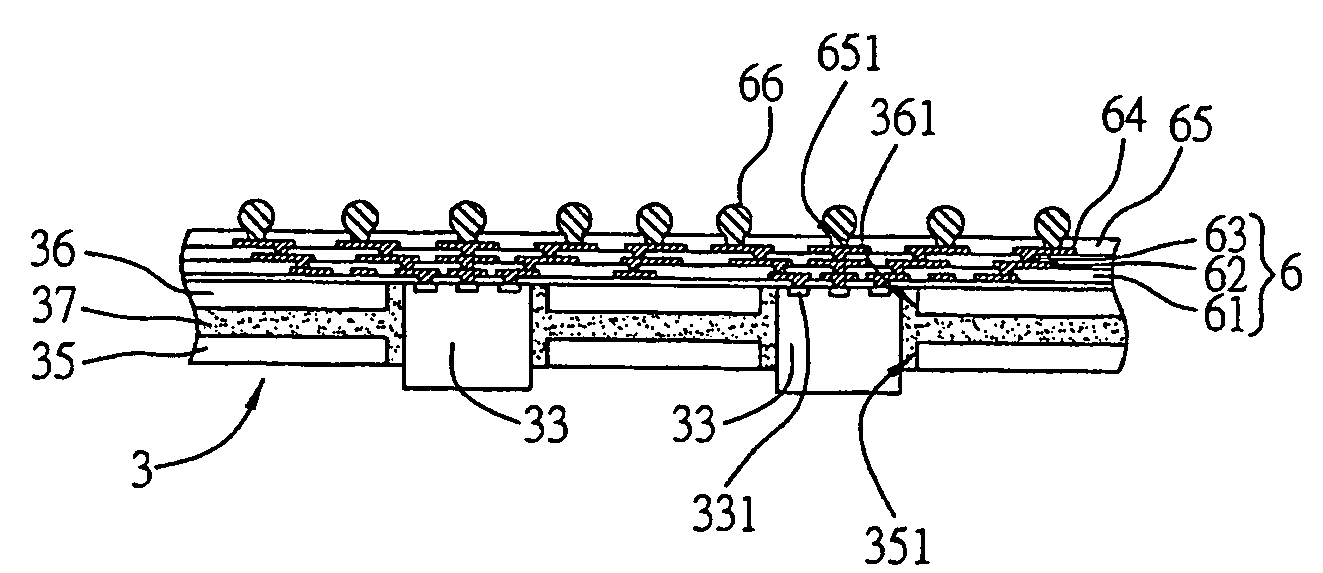Carrying structure of electronic components
a technology of electronic components and carrying structures, applied in the direction of semiconductor devices, multilayer circuit manufacturing, semiconductor/solid-state device details, etc., can solve the problems of long production cycle, unsatisfactory quality of production, and inability to further improve electrical properties, so as to improve reliability of fabrication processes, reduce production costs, and improve manufacturing processes.
- Summary
- Abstract
- Description
- Claims
- Application Information
AI Technical Summary
Benefits of technology
Problems solved by technology
Method used
Image
Examples
first embodiment
[0023]The carrying structure of electronic components comprises a supporting board with at least one cavity; at least one electronic component having an active face and a non-active face provided in the corresponding cavity of the supporting board; and at least one adhesive layer formed on a surface of the supporting board, wherein the adhesive layer partly fills a gap between the cavity and the electronic component, such that the electronic component is fixed in the cavity of the supporting board.
[0024]Referring now to FIGS. 2A and 2B showing schematic diagrams of the carrying structure of electronic components of the present invention. The carrying structure 2 comprises a supporting board 25 having at least one cavity 251, wherein an adhesive layer 27 is formed on a surface of the supporting board 25. In this embodiment, the carrying structure 2 may be for example a double-layered structure comprising the supporting board 25 and the adhesive layer 27 formed on the surface of the s...
second embodiment
[0028]The carrying structure of electronic components of this embodiment comprises at least a first supporting board and a second supporting board having at least one cavity, respectively; at least one adhesive layer formed between the first and the second supporting boards; and at least one electronic component comprising an active and non-active face provided in the corresponding cavities of the first and second supporting boards, wherein a portion of the adhesive layer fills a gap between the electronic element and the cavities of the first and second supporting boards, thereby mounting the electronic component in the cavities of the first and second supporting boards.
[0029]Referring to FIGS. 3A to 3C, schematic diagrams of a carrying structure 3 for electronic component according to another embodiment of the present invention are shown. The second embodiment essentially differs from the first embodiment in that the carry structure 3 is a multi-layered structure with at least one...
third embodiment
[0034]Referring to FIGS. 4A to 4C, schematic diagrams of a carrying structure of electronic components according to still another embodiment of the present invention are shown, wherein like elements are designated with like reference numerals and will not be described in detail in order to not obscure the features of the present invention.
[0035]As shown in FIG. 4A, the carrying structure comprises a supporting board 25, at least one electronic component 23 and an adhesive layer 27 formed on a surface of the supporting board 25.
[0036]The supporting board 25 has at least one cavity 251. Although the carrying structure 2 is shown as a two-layered structure comprising the supporting board 25 and the adhesive layer 27, however the present invention is not limited to this.
[0037]The electronic component 23 has an active face and a non-active face, where the active face is on the top surface and the non-active face is on bottom surface. The electronic component 23 is disposed in the cavity ...
PUM
 Login to View More
Login to View More Abstract
Description
Claims
Application Information
 Login to View More
Login to View More - R&D
- Intellectual Property
- Life Sciences
- Materials
- Tech Scout
- Unparalleled Data Quality
- Higher Quality Content
- 60% Fewer Hallucinations
Browse by: Latest US Patents, China's latest patents, Technical Efficacy Thesaurus, Application Domain, Technology Topic, Popular Technical Reports.
© 2025 PatSnap. All rights reserved.Legal|Privacy policy|Modern Slavery Act Transparency Statement|Sitemap|About US| Contact US: help@patsnap.com



